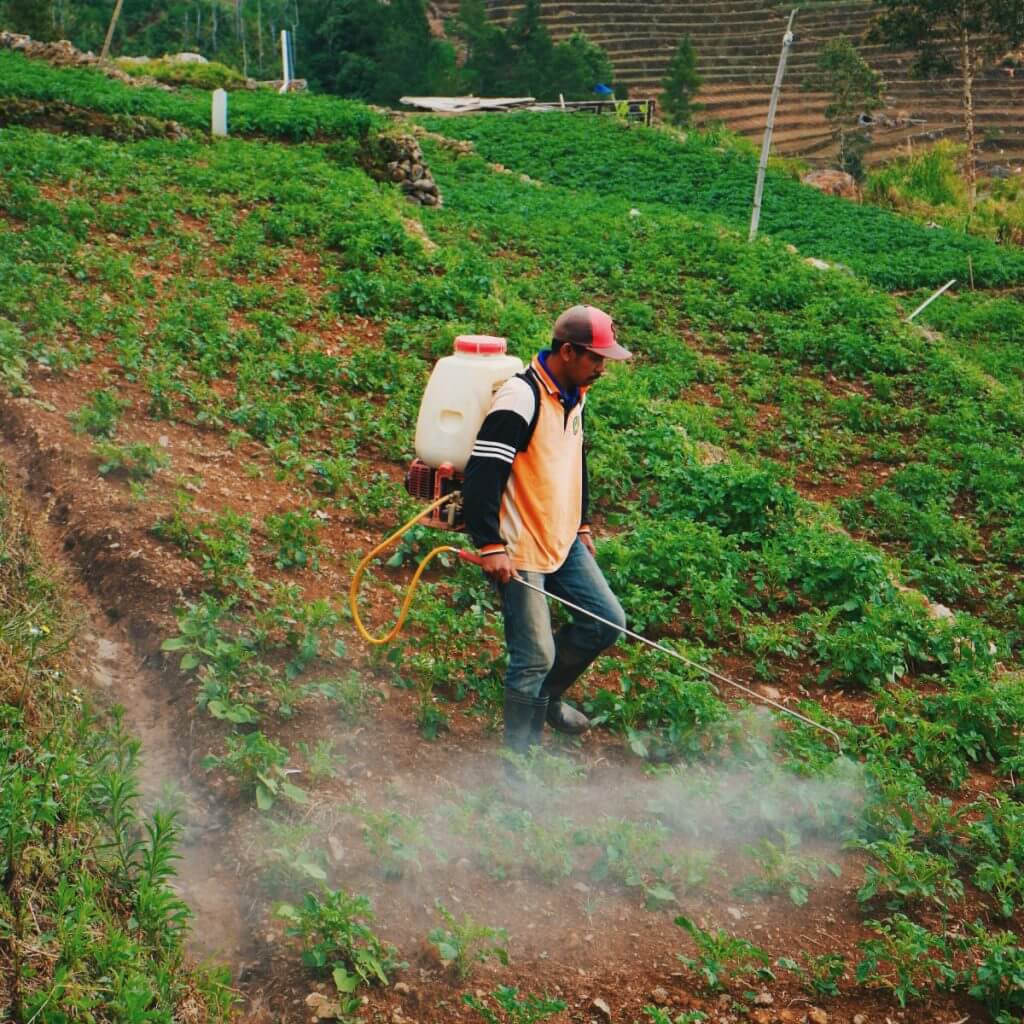By Eliane Hauri

The soil is a living thing, an essential common good where the path of our food starts, which I would like clean “from farm-to-fork” for the sake of human health as well as the health of the planet.
I became interested in soils around 2012 when I was still living in Europe and witnessed how a French scientific couple, Claude and Lydia Bourguignon, became famous in ecology circles for the fórmulas shock they used in their interviews. Claude and Lydia used to start their statements with: “Soils are dead. We have massacred them; it is already a desert what we have. Tilling the soil never has to be done; soil has been raped” (Jeunehomme, 2017).
One question I remember from my first classes in agronomy was: is the soil a living thing? I answered: yes, it is. As a result of this couple, I got interested in this topic, which is of great importance not only for agriculture, but also for biodiversity as a whole.
The UN General Assembly declared 2015 as the International Year of Soils (1) and the FAO defined its importance in its publication of that year on “Soils and Biodiversity”: “Soil is one of nature’s most complex ecosystems and one of the most diverse habitats on earth: it contains a myriad of different organisms, which interact and contribute to the global cycles that make all life possible. Nowhere in nature are species so densely packed as in soil communities; however, this biodiversity is little known as it is underground and largely invisible to the human eye.” (2)
The importance of soils
To understand the importance of soils, I thought it would be interesting to take as a reference one of the publications of the international Slow Food movement, dedicated above all to promote good food. Founded in the 1980s by the Italian Carlo Petrini with the aim of defending regional traditions that now exist in more than 160 countries. This movement has evolved to incorporate a “global approach to food that recognizes the strong relationships between our food, culture and our planet”. (3)
The movement’s motto is “Good, Clean and Fair”
Food has to be tasty and in-season fresh, becoming part of the local culture; it has to be clean through a process that does not harm the environment, animal welfare or human health; and fair in terms of remuneration for producers and affordable prices for consumers. (4) As such, we understand that everything is a cycle, which starts from the soil and ends at the final point, namely your plate and fork.
A study on the importance of soils was published by Slow Food in 2016 and in its introduction the author declares: “Soil is the only environmental compartment in which all the other environmental compartments simultaneously meet, interact and interface with each other. Indeed, soil is a fundamental and irreproducible natural resource on which all the planet’s life depends. For too long, soil has been considered an inert material, reduced to a simple support for rowing crops, with no consideration of its. It is treated aggressively, without taking into account its complexity or thinking about the risks to biodiversity at the microflora and microfauna level, not to mention environmental equilibriums.” (Messa, 2016) (5)
According to the analyst, Marta Messa, it is stated that soil delivers around 99% of global food supplies for human consumption, filters rainwater that returns it clean and potable, regulates the climate and is an essential reserve of both organic carbon and biodiversity. (6)
However, despite its immense value to humanity, soil is under threat. “Soil is today subject to many processes of rapid degradation—erosion, contamination, salinization, sealing,etc.—many of which are directly or indirectly caused by human activities.” (7)
How did these threats to the soil begin?
As Dr. Vandana Shiva, ecologist and food sovereignty advocate recalls, the industrialization of agriculture after the two European world wars happened because the arms industry was reoriented to produce synthetic fertilizers and pesticides. In fact, these wars were catalysts for the incipient chemical industry. In 1913, the synthesis of nitrogen from air made it possible not only to produce explosives, but also nitrogen fertilizers (Shiva, 2016).
(According to Slow Food, precisely, worldwide, nitrogen accounts for 74% of mineral fertilizer use; in some countries this figure is as high as 90%, along with the potential effects to the environment implied by this value). (8)
Similarly, it is known how the U.S. spread the famous herbicide and defoliant “agent orange” over the jungle during the Vietnam War to kill it, as well as the crops in the area, to ultimately kill the Vietnamese populations and soldiers. (9) The ingredients of “agent orange” were manufactured by the Monsanto company, (now MonsantoBayer), well-known for its sale of transgenic seeds. The herbicide “Agent Orange” was part of the chemical warfare program used by the United States. (10)
Nitrogen in Soils
During the 20th century, air-based nitrogen synthesis, which allowed the production of explosives as well as nitrogen fertilizers, led to an excess of nitrogen, which caused serious soil deterioration. Excessive nitrogen in soils prevents plant roots from releasing nutrients for microorganisms. (11)
“Maximum nitrogen values are reached in areas where factory farming is practiced, fruit and vegetables are cultivated industrially or grain is produced with excessive fertilization.” (12)
“The largest use of nitrogen compounds in Europe is to make fertilizers used in areas dedicated to grow fodder crops for animals. The roots of the crops do not take up all of the nitrogen from the fertilizers applied to the field. Then, when the fodder is fed to livestock, the animals do not absorb all the nitrogen it contains and expel it in their urine and dung.” Marta Messa, Slow Food’s analyst, describes how an excess of nitrogen (often in the form of nitrate) may be washed into rivers and leached from the soil into underground water, contaminating sources of drinking water and damaging aquatic and marine ecosystems. Furthermore, excess nitrogen in the soil leads to an increase in the mineralization of organic matter, which in turn leads to an increased loss of carbon from soils. The use of synthetic fertilizers has greatly contributed to the impoverishment of the soil and has caused a drastic depletion of the essential organic matter that is needed.
Soil Degradation and Climate Change
According to Messa, “one of the most serious consequences of the application of the industrial agricultural model is the fundamental and generally ignored contribution to climate change, which in turn becomes a generator of further deterioration and accelerates desertification. Climate and soil are closely connected: the climate affects soil formation and soil in turn affects the composition of the atmosphere, in particular the amount of carbon dioxide and other greenhouses gases. (15)
This Slow Food study, which recognizes the health of the soil and crops as a whole, states that: “Soil contains more carbon than the atmosphere and all terrestrial vegetation combined. Relatively small changes to the amount of organic matter in the soil can have significant effects on the atmosphere and global warming. Of course, we can understand how climate change is a serious threat to global food security” (16)
Industrial agriculture and soils
The so-called “Green Revolution” of the 1970’s, an agricultural revolution of the 20th century, encouraged uniformity and agricultural over-productivity, which dramatically increased the production and profitability. Such “Revolution” was a “process of development and expansion of high productivity seeds and agricultural techniques in several Third World countries during the 1960s and early 1970s, under the impulse of an FAO plan.” (Due Process Foundation, 2017)
The “Green Revolution” prompted the implementation of intensive agriculture through monocultures (Carrera Ríos & Kucharz, 2006). As a result, monocultures have depleted the world’s soils by relying on a scarce number of varieties to only respond on the needs of the world market and not to respond to the needs of producing food for the majority of the planet (Expansion of large-scale monocultures endangers small-scale agriculture in LA, 2014).
In Guatemala, the large monocultures we know, such as sugarcane, require significant amounts of fertilizers and pesticides, harmful not only to health but also to the environment. (17)
The situation in Guatemala
According to researcher José Miguel Leiva Pérez, soil conservation does not currently have any priority in Guatemala within agricultural production and natural resource protection strategies, despite the fact that annual national average soil loss in the country due to erosion reaches 148 million tons (Leiva Pérez, 2016).
As reported by the Institute of Agriculture; Natural Resources and Environment (IARNA) within its 2014 study regarding the profile of agriculture and rurality in Guatemala, there are 37% of the country’s surface area that is used below its maximum potential. Meanwhile, 15% of the country’s surface area is used for activities that exceed its capacity. An estimated 148 million tons of soil can be lost in that percentage of the country’s surface due to intensity of use and erosion. The IARNA indicates that even in properly used lands erosion potential exists.
Aspects such as deforestation are linked to the erosion process. Deforestation and climatically unsustainable agricultural and livestock activities are among the most important causes of soil loss and degradation in Guatemala. And as we may have already understood, agriculture is the activity that represents the highest percentage of potential erosion due to land overuse (Leiva Pérez, Pérdida acelerada de tierras agrícolas en Guatemala, Programa de Cambio Climático, Facultad de Agronomía, USAC, 2017).
Leiva Pérez states that the country’s vulnerability to the phenomenon of climate change is evident, which is accelerating the processes of drought and land degradation within Guatemala. The loss of agricultural soils and the overall erosion of land exposes a significant number of the country’s rural population to processes of food insecurity. (18)
According to this author, the country does not have any legal regulations that address sustainable land management, especially in terms of soil conservation and rehabilitation.
In conclusion, it is hoped that we understand how everything is a circle that has to be respected and realize that, from our food and consumption, the impact on climate, biodiversity and soil, our common good, is of great importance.
Dear readers, I hope this article raised some awareness and curiosity about the origins of the food on your plate, beginning with the soil itself until it reaches your kitchen.
REFERENCES
Carrera Ríos, B., & Kucharz, T. (noviembre de 2006). Las insostenibilidad de los monocultivos agro-industriales. Obtenido de https://www.ecologistasenaccion.org/: https://spip.ecologistasenaccion.org/IMG/pdf/Las_insostenibilidad_de_los_monocultivos_agroalimentarios.pdf
Expansión de monocultivos a gran escala pone en peligro la pequeña agricultura en AL. (abril de 2014). Obtenido de https://derechoalimentacion.org/: https://derechoalimentacion.org/noticias/expansi-n-de-monocultivos-gran-escala-pone-en-peligro-la-peque-agricultura-en-al
Fundación para el Debido Proceso DPLF). (septiembre de 2017). Organizaciones de Centroamérica denuncian ante la CIDH impacto de monocultivos y agrotóxicos en los derechos humanos. Obtenido de http://www.dplf.org/es/news/organizaciones-de-centroamerica-denuncian-ante-la-cidh-impacto-de-monocultivos-y-agrotoxicos-en
Galvez, J. A. (2014). Perfil del agro y la ruralidad de Guatemala: situación actual y tendencias. Universidad Rafael Landívar. Instituto de Agricultura; Recursos Naturales y Ambiente (IARNA). Guatemala Ciudad: Cara Parens: IICA.
Gutierrez, J. (s.f.). Revolución verde. Obtenido de http://www.dicc.hegoa.ehu.es/listar/mostrar/192
Jeunehomme, A. (2017). Lydia et Emmanuel Bourguignon. Obtenido de www.revue-openfield.net: https://www.revue-openfield.net/2018/07/03/lydia-et-emmanuel-bourguignon/
José Miguel, L. P. (agosto de 2016). La degradación de las tierras agrícolas en Guatemala. Obtenido de http://iia.fausac.gt/: http://iia.fausac.gt/wp-content/uploads/2016/08/PONENCIA-DEGRADACI%C3%93N-SUELOS.pdf
José Miguel, L. P. (2017). Pérdida acelerada de tierras agrícolas en Guatemala, Programa de Cambio Climático, Facultad de Agronomía, USAC. Obtenido de https://issuu.com/ipnusac/docs/revista_edici__n_101/117
Messa, Marta. (2016). El suelo, Análisis de Slow Food. Obtenido de: https://www.slowfood.com/sloweurope/wp-content/uploads/SPA_suolo.pdf
Shiva, V. (2016). Monsanto Merges with Bayer, “Their Expertise is War”. Shady Historical Origins, IG Farben, Part of Hitler’s Chemical Genetic Engineering Cartel, Global Research, Centre for Research on Globalization (CRG). Obtenido de: https://www.globalresearch.ca/monsanto-merges-with-bayer-their-expertise-is-war-shady-historical-origins-ig-farben-part-of-hitlers-chemical-genetic-engineering-cartel/5546121
Suelos y Biodiversidad. Los suelos albergan una cuarta parte de la biodiversidad de nuestro planeta. (2015). Obtenido de: http://www.fao.org/3/a-i4551s.pdf
